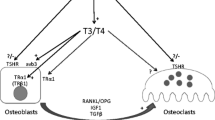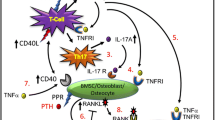Abstract
Studies involving human genetic mutations and mutant mouse models have provided irrevocable evidence for a key role for thyroid hormones (THs) in the regulation of skeletal growth. While T3 binds to TH receptors with higher affinity than T4, T4 occupied TH receptors have also been reported in the nucleus under euthyroid conditions raising the possibility that T4 bound nuclear receptors may be biologically relevant in thyroid syndromes with elevated free T4 and reduced T3 levels. We, therefore, evaluated the direct effects of T4, T3, and their metabolites (rT3 and T2) in stimulating osteoblast differentiation using MC3T3-E1 preosteoblasts which do not produce detectable levels of deiodinases. Under serum-free conditions, a 24-h treatment of MC3T3-E1 cells with THs and their metabolites caused a dose-dependent increase in the expression of osteoblast differentiation markers, osterix, and osteocalcin. Circulating concentrations of T3 (~1 ng/ml) and T4 (~30 ng/ml) showed similar potency in stimulating osteoblast differentiation marker expression, while rT3 and T2 were less potent than T3 and T4. Moreover, T3 and T4 treatments elevated the IGF-1 mRNA level suggesting the involvement of IGF-1 signaling in the TH regulation of osteoblast differentiation. We conclude that an elevated T4 level in the absence of T3 may exert stimulatory effects on osteoblast differentiation. The establishment of cell-specific effects of T4 on osteoblasts may provide a strategy to generate T4 mimics that exert skeletal specific effects without the confounding T3 effects on other tissues.






Similar content being viewed by others
References
Bochukova E, Schoenmakers N, Agostini M, Schoenmakers E, Rajanayagam O, Keogh JM, Henning E, Reinemund J, Gevers E, Sarri M, Downes K, Offiah A, Albanese A, Halsall D, Schwabe JW, Bain M, Lindley K, Muntoni F, Vargha-Khadem F, Dattani M, Farooqi IS, Gurnell M, Chatterjee K (2012) A mutation in the thyroid hormone receptor alpha gene. N Engl J Med 366:243–249
Rivkees SA, Bode HH, Crawford JD (1988) Long-term growth in juvenile acquired hypothyroidism: the failure to achieve normal adult stature. N Engl J Med 318:599–602
Harvey CB, O’Shea PJ, Scott AJ, Robson H, Siebler T, Shalet SM, Samarut J, Chassande O, Williams GR (2002) Molecular mechanisms of thyroid hormone effects on bone growth and function. Mol Genet Metab 75:17–30
Kim HY, Mohan S (2013) Role and mechanisms of actions of thyroid hormone on the skeletal development. Bone Res 1:146–161
Xing W, Govoni KE, Donahue LR, Kesavan C, Wergedal J, Long C, Bassett JH, Gogakos A, Wojcicka A, Williams GR, Mohan S (2012) Genetic evidence that thyroid hormone is indispensable for prepubertal insulin-like growth factor-I expression and bone acquisition in mice. J Bone Miner Res 27:1067–1079
Schlesinger S, MacGillivray MH, Munschauer RW (1973) Acceleration of growth and bone maturation in childhood thyrotoxicosis. J Pediatr 83:233–236
Eriksen EF, Mosekilde L, Melsen F (1986) Kinetics of trabecular bone resorption and formation in hypothyroidism: evidence for a positive balance per remodeling cycle. Bone 7:101–108
Vestergaard P, Mosekilde L (2002) Fractures in patients with hyperthyroidism and hypothyroidism: a nationwide follow-up study in 16,249 patients. Thyroid 12:411–419
Vestergaard P, Rejnmark L, Weeke J, Mosekilde L (2000) Fracture risk in patients treated for hyperthyroidism. Thyroid 10:341–348
Ahmed LA, Schirmer H, Berntsen GK, Fonnebo V, Joakimsen RM (2006) Self-reported diseases and the risk of non-vertebral fractures: the Tromso study. Osteoporos Int 17:46–53
Flynn RW, Bonellie SR, Jung RT, MacDonald TM, Morris AD, Leese GP (2010) Serum thyroid-stimulating hormone concentration and morbidity from cardiovascular disease and fractures in patients on long-term thyroxine therapy. J Clin Endocrinol Metab 95:186–193
Vestergaard P, Rejnmark L, Mosekilde L (2005) Influence of hyper- and hypothyroidism, and the effects of treatment with antithyroid drugs and levothyroxine on fracture risk. Calcif Tissue Int 77:139–144
Visser TJ (1996) Pathways of thyroid hormone metabolism. Acta Med Austriaca 23:10–16
Bianco AC (2011) Minireview: cracking the metabolic code for thyroid hormone signaling. Endocrinology 152:3306–3311
Hulbert AJ (2000) Thyroid hormones and their effects: a new perspective. Biol Rev Camb Philos Soc 75:519–631
Wojcicka A, Bassett JH, Williams GR (2013) Mechanisms of action of thyroid hormones in the skeleton. Biochim Biophys Acta 1830:3979–3986
Lazar MA (1993) Thyroid hormone receptors: multiple forms, multiple possibilities. Endocr Rev 14:184–193
Mangelsdorf DJ, Thummel C, Beato M, Herrlich P, Schutz G, Umesono K, Blumberg B, Kastner P, Mark M, Chambon P, Evans RM (1995) The nuclear receptor superfamily: the second decade. Cell 83:835–839
Mullur R, Liu YY, Brent GA (2014) Thyroid hormone regulation of metabolism. Physiol Rev 94:355–382
Banovac K, Koren E (2000) Triiodothyronine stimulates the release of membrane-bound alkaline phosphatase in osteoblastic cells. Calcif Tissue Int 67:460–465
Varga F, Rumpler M, Luegmayr E, Fratzl-Zelman N, Glantschnig H, Klaushofer K (1997) Triiodothyronine, a regulator of osteoblastic differentiation: depression of histone H4, attenuation of c-fos/c-jun, and induction of osteocalcin expression. Calcif Tissue Int 61:404–411
Varga F, Rumpler M, Zoehrer R, Turecek C, Spitzer S, Thaler R, Paschalis EP, Klaushofer K (2010) T3 affects expression of collagen I and collagen cross-linking in bone cell cultures. Biochem Biophys Res Commun 402:180–185
Gouveia CH, Schultz JJ, Bianco AC, Brent GA (2001) Thyroid hormone stimulation of osteocalcin gene expression in ROS 17/2.8 cells is mediated by transcriptional and post-transcriptional mechanisms. J Endocrinol 170:667–675
Halperin Y, Shapiro LE, Surks MI (1991) Role of L-thyroxine in nuclear thyroid hormone receptor occupancy and growth hormone production in cultured GC cells. J Clin Invest 88:1291–1299
Horowitz ZD, Sahnoun H, Pascual A, Casanova J, Samuels HH (1988) Analysis of photoaffinity label derivatives to probe thyroid hormone receptor in human fibroblasts, GH1 cells, and soluble receptor preparations. J Biol Chem 263:6636–6642
Sato K, Han DC, Fujii Y, Tsushima T, Shizume K (1987) Thyroid hormone stimulates alkaline phosphatase activity in cultured rat osteoblastic cells (ROS 17/2.8) through 3,5,3′-triiodo-L-thyronine nuclear receptors. Endocrinology 120:1873–1881
Sandler B, Webb P, Apriletti JW, Huber BR, Togashi M, Cunha Lima ST, Juric S, Nilsson S, Wagner R, Fletterick RJ, Baxter JD (2004) Thyroxine-thyroid hormone receptor interactions. J Biol Chem 279:55801–55808
Bergh JJ, Lin HY, Lansing L, Mohamed SN, Davis FB, Mousa S, Davis PJ (2005) Integrin alphaVbeta3 contains a cell surface receptor site for thyroid hormone that is linked to activation of mitogen-activated protein kinase and induction of angiogenesis. Endocrinology 146:2864–2871
Williams AJ, Robson H, Kester MH, van Leeuwen JP, Shalet SM, Visser TJ, Williams GR (2008) Iodothyronine deiodinase enzyme activities in bone. Bone 43:126–134
Cheng S, Zhao SL, Nelson B, Kesavan C, Qin X, Wergedal J, Mohan S, Xing W (2012) Targeted disruption of ephrin B1 in cells of myeloid lineage increases osteoclast differentiation and bone resorption in mice. PLoS One 7:e32887
Govoni KE, Linares GR, Chen ST, Pourteymoor S, Mohan S (2009) T-box 3 negatively regulates osteoblast differentiation by inhibiting expression of osterix and runx2. J Cell Biochem 106:482–490
Hernandez A, Martinez ME, Fiering S, Galton VA, St Germain D (2006) Type 3 deiodinase is critical for the maturation and function of the thyroid axis. J Clin Invest 116:476–484
Hojo H, Ohba S, Yano F, Chung UI (2010) Coordination of chondrogenesis and osteogenesis by hypertrophic chondrocytes in endochondral bone development. J Bone Miner Metab 28:489–502
Wuelling M, Vortkamp A (2010) Transcriptional networks controlling chondrocyte proliferation and differentiation during endochondral ossification. Pediatr Nephrol 25:625–631
Otto F, Thornell AP, Crompton T, Denzel A, Gilmour KC, Rosewell IR, Stamp GW, Beddington RS, Mundlos S, Olsen BR, Selby PB, Owen MJ (1997) Cbfa1, a candidate gene for cleidocranial dysplasia syndrome, is essential for osteoblast differentiation and bone development. Cell 89:765–771
Rumpler M, Woesz A, Varga F, Manjubala I, Klaushofer K, Fratzl P (2007) Three-dimensional growth behavior of osteoblasts on biomimetic hydroxyapatite scaffolds. J Biomed Mater Res A 81:40–50
Williams GR (2013) Thyroid hormone actions in cartilage and bone. Eur Thyroid J 2:3–13
Lakatos P, Caplice MD, Khanna V, Stern PH (1993) Thyroid hormones increase insulin-like growth factor I content in the medium of rat bone tissue. J Bone Miner Res 8:1475–1481
Varga F, Rumpler M, Klaushofer K (1994) Thyroid hormones increase insulin-like growth factor mRNA levels in the clonal osteoblastic cell line MC3T3-E1. FEBS Lett 345:67–70
Varga F, Spitzer S, Rumpler M, Klaushofer K (2003) 1,25-Dihydroxyvitamin D3 inhibits thyroid hormone-induced osteocalcin expression in mouse osteoblast-like cells via a thyroid hormone response element. J Mol Endocrinol 30:49–57
Yoshimasa Y, Hamada S (1983) Thyroxine action on the rat liver nuclear thyroid-hormone receptors. Binding of thyroxine to the nuclear non-histone protein and induction of mitochondrial alpha-glycerophosphate dehydrogenase activity. Biochem J 210:331–337
Tuchendler D, Bolanowski M (2014) The influence of thyroid dysfunction on bone metabolism. Thyroid Res 7:12
Davis PJ, Goglia F, Leonard JL (2015) Nongenomic actions of thyroid hormone. Nat Rev Endocrinol 12:111–121
Davis FB, Cody V, Davis PJ, Borzynski LJ, Blas SD (1983) Stimulation by thyroid hormone analogues of red blood cell Ca2+-ATPase activity in vitro. Correlations between hormone structure and biological activity in a human cell system. J Biol Chem 258:12373–12377
Acknowledgments
The research work was performed at facilities provided by the Department of Veterans Affairs. This study was supported by funding from National Institutes of Health (NIH R01 048139) and from Veterans Administration Senior Research Career Scientist Award to SM.
Author information
Authors and Affiliations
Corresponding author
Ethics declarations
Conflict of interest
Shaohong Cheng, Weirong Xing, Sheila Pourteymoor, and Subburaman Mohan declare that they have no conflicts of interest or financial interest to disclose.
Ethical approval
This study was performed using an established mouse osteoblast cell line, MC3T3-E1, and was approved by the Research and Development Committee at VA Loma Linda Healthcare System.
Electronic supplementary material
Below is the link to the electronic supplementary material.
Rights and permissions
About this article
Cite this article
Cheng, S., Xing, W., Pourteymoor, S. et al. Effects of Thyroxine (T4), 3,5,3′-triiodo-l-thyronine (T3) and their Metabolites on Osteoblast Differentiation. Calcif Tissue Int 99, 435–442 (2016). https://doi.org/10.1007/s00223-016-0159-x
Received:
Accepted:
Published:
Issue Date:
DOI: https://doi.org/10.1007/s00223-016-0159-x




